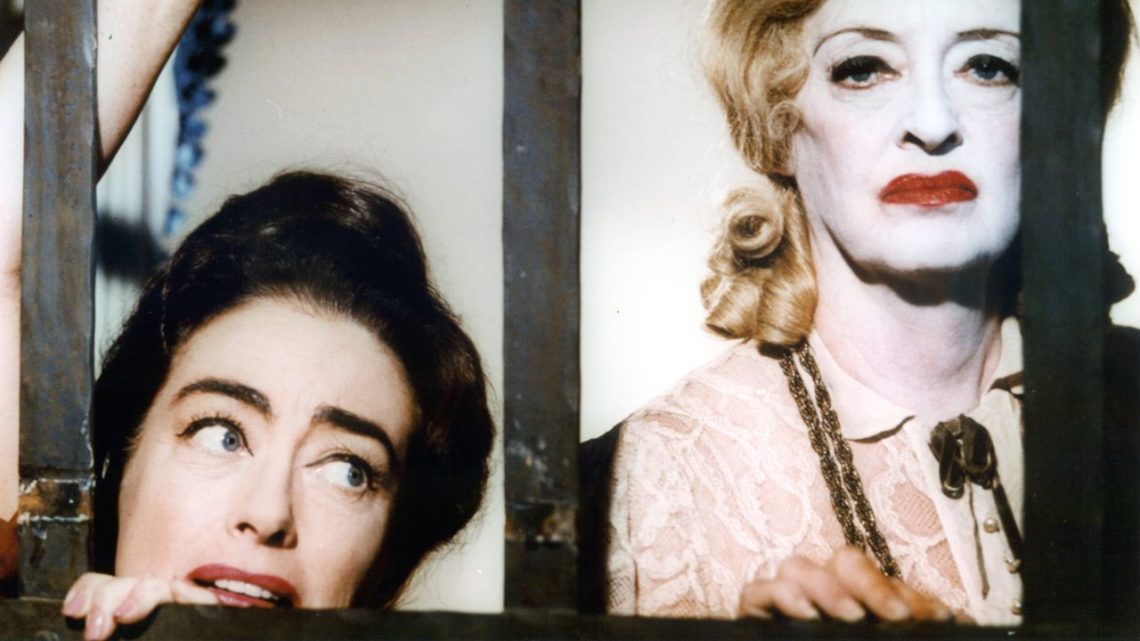As much as Bette Davis disliked Joan Crawford, she was compelled to admit that she owed her: “I will always thank her for giving me the opportunity to play the part of Baby Jane Hudson.”
Both the novel and the screenplay of What Ever Happened to Baby Jane? form a compelling Gothic grotesque that offered strong parts for two actresses who hadn’t had one in a long time. Neither Davis nor Crawford was being hotly pursued by other offers, so negotiations didn’t take that long, but not before considerable maneuvering about money and billing. Initial offers gave Davis more cash up front but less of a percentage of the profits than Crawford—Davis was to get $60,000 and 5 percent of the profits, while Crawford was to get $40,000 and 10 percent. Billing was to imitate John Ford’s The Man Who Shot Liberty Valance, where John Wayne got first position on the film itself and James Stewart got first position on all advertising.
But Davis realized that while Crawford’s part could conceivably be played by a couple of other actresses, Baby Jane could only be played by someone willing to risk complete embarrassment—an alcoholic sixty-something harridan dressed in a Mary Pickford pinafore and sporting whiteface makeup. By the time the contracts were signed, Davis got top billing and certain consultation rights. The agreement was signed on May 9, 1962, with Crawford signing on for $30,000 and 15 percent of the profits. The contract had initially stated that she and Davis would have equal costar billing, which was crossed out in favor of giving Davis top billing and in the same size as the film’s title.
“When it came to the short strokes . . . Davis became difficult, Crawford was ever malleable,” wrote Aldrich to an associate.
Contracts finally in hand, Aldrich went shopping for money and couldn’t find any. Joseph E. Levine had originally agreed to front the $850,000 budget, but dropped out, and every major studio turned the picture down. The problem was the stars, both of whom were regarded as elderly has-beens.
Aldrich remained committed to the picture. He widened his net and finally got the film financed by Eliot Hyman, who owned a company called Seven Arts that had bought the TV rights to Warners’ backlog of pictures. Since Hyman was financing, Jack Warner agreed to distribute the picture on a straight percentage basis.
Aldrich had his stars, but the budget meant he would have to make the picture at top speed; the shooting schedule would be six weeks—a pace the stars hadn’t seen since their earliest days in the picture business. What this meant in practice was that there would be no time for time-sucking spats and arguments that held up production. This would be a sprint, not a stroll.
What Ever Happened to Baby Jane? began shooting on Friday, July 27, and finished on Tuesday, September 11, 1962. The documentation indicates there were occasional tremors but no actual earthquakes, as with this from a document labeled “Davis Diary”: “Call from Director to determine health of Miss Davis . . . met with ‘Why is Edna [a] Negro’ argument’ terminated by hang-up.
“Called Back . . . left name . . . Davis did not return call.”
As for the relationship between the two stars, which has occasioned flamboyant fan fiction masquerading as film history and at least one TV series, Aldrich would say, “I think it’s proper to say that they really detested each other, but they behaved absolutely perfectly: no upstaging, not an abrasive word in public. They both behaved in a wonderfully professional manner.”
Davis’s take was grudging: “Joan was a pro. She was always punctual, always knew her lines. She had a deep and gnawing need to be liked, loved, admired, appreciated. She could be touchingly generous. She brought gifts for me to the set and presented them in front of the crew.”
But there was a competition, and according to Davis it had begun years earlier, when she had a mad crush on Franchot Tone when they made Dangerous together at Warner Bros. in 1935. She couldn’t get to first base because it was obvious that he was involved with Crawford back at MGM.
A publicist working on Baby Jane planted an item in Time magazine about the picture. The editors interpolated a bitchy line about both stars “professing to be 55.”
On the soundstage the next day, Davis called out to Linn Unkefer, the publicist: “Linn, come in here!”
“Good morning, Bette.”
“Did you have anything to do with this item?”
“Yes.”
“She’s five years older than I am if she’s a day!” Davis snapped.
The publicist proceeded to Crawford’s dressing room. She also called him in and also had a copy of Time. “Well, we’re getting off to a good start, aren’t we?”
“Bette was very . . . well-educated,” said the screenwriter Lenore Coffee, who wrote for both actresses. “Joan was not. Bette came from a good family and was a trained theater actress. Joan had taught herself to speak and she spoke very well. I had great admiration for her.”
When she was asked about distinguishing between their personalities, Coffee said succinctly, “I think Joan would be more susceptible. I think Bette could be pretty tough.”
In fact, Crawford and Davis embodied many of the same characteristics. Crawford was far more amenable to direction than Davis, who generally treated directors as obstacles God unaccountably placed between her and the audience. She only submitted when confronted with a stronger will—William Wyler, for instance. Both sought to control their professional trajectories as much as possible by seducing their directors, either through charm, dominance, or sex. And there was another crucial difference. Crawford wanted a happy set, while Davis was stimulated by aggravation and tension. If nothing aggravated her, she’d search for something that would.
Director Vincent Sherman would remember that “In life and offscreen, Bette was simple, forthright, honest and unaffected. The moment she began playing a role she became actorish and theatrical. Joan, on the other hand, was simple, forthright, honest and unaffected when playing a role, but in life she was exactly the opposite: actorish, theatrical and affected.
“Bette dressed poorly and never seemed to care much how she looked, whereas Joan was always well-dressed and highly conscious of how she appeared. Bette never thought of herself as being beautiful or attractive, whereas Joan was sure of her beauty and dedicated her life to taking care of it. Finally, I think sex for Bette was a biological need, while for Joan it was primarily an ego trip.”
With his intimate knowledge of both women, Sherman got to the point. “Davis and Crawford . . . disliked each other, but they were really sisters under the skin. Both of their fathers left their mothers when they were very young, so they were afraid of rejection; even expected to be rejected. They distrusted men and, in lay psychology, therefore emasculated them as a sort of defensive preventative measure. They needed to be in control.”
Robert Aldrich knew both women quite well, and outlined to his associate Eugene Lester how to behave: “I know you would normally think of it but under the terrible pressures you must be operating under you might just forget and, knowing the schizophrenic feline as opposed to the feminine mind of Crawford, I would only suggest that you somehow find the time to ‘make her an emotional partner’ of everything that has gone on. I don’t mean that you should donate your lily-white body but if she feels she has been ‘left out’ there will be hell to pay. Okay? Okay.”
Lester responded by sending a stream of floral bouquets to Crawford, who invariably responded with gracious thank-you notes: “Gene dear, How wonderful it was to see you. Thank you so much for the beautiful red roses. I am so deeply grateful to you. I’m sorry our little visit was so short, but it was good, even briefly, to see that happy face of yours. Bless you and thank you again for your kindnesses.”
According to Linn Unkefer, the closest thing to an outburst occurred when Crawford was in her wheelchair on the set while laboring beneath a cold. She asked Aldrich if she could take a break for a few minutes, which led Davis to say loudly, “You’d think by now we’d all be troupers.” Crawford stared at Davis then got up and walked away, while Aldrich took Davis aside and cooled her down. Other than that, there was a minimum of chitchat.
Publicists had to adapt their methods to the individual personalities of the stars. Davis tended toward grumpy and Unkefer had to cajole her to do interviews. With Crawford, all she had to do was give her a briefing on the reporter so she wouldn’t walk into the interview blind.
The only real professional problem arose from the fact that the two stars had different ways of working. Davis went full tilt in both rehearsal and performance, while Crawford walked through rehearsals to get her movements and dramatic beats, but didn’t give a full performance until the camera rolled. “I never give until the camera’s turned,” said Crawford. “You know, how much can you give of yourself? Why give it anyway, for God’s sakes, it’s not being recorded.”
This eventually led to Davis turning to Robert Aldrich and snapping, “Mr. Aldrich!” and stalking into her dressing room. After a while Aldrich emerged to find Crawford had been passing the intervening time by knitting. “Can I be helpful?” she inquired. Davis wanted to know when Crawford was going to “give me some emotion to work against?”
Aldrich had worked with Crawford before and knew how she worked. “Bette,” he told her, “when the camera’s rolling.”
“There was never a feud because it takes two to tango and I refuse to fight,” Crawford said more than ten years after the film was shot. “I’m not going to waste my energy on anything or anybody until that camera goes! Nobody can entice me into that; nobody can goad me into it.”
While voices were never raised, the underlying tension was real. Davis would claim that Crawford had three sizes of falsies, that Aldrich had to struggle to strip Crawford of glamorous makeup and wardrobe, even though squalor is intrinsic to the characters and the setting.
“I could feel all those evil vibes slipping through the doors,” said Anna Lee, who was playing the nosy next-door neighbor. “Bette was quite nice to me because her chunky daughter B.D. was playing my daughter. With Joan there was a polite distance. Cases of Pepsi arrived daily for the crew. It is true that Joan weighed herself down with jockey weights when Bette had to drag her across the floor It was all quite tense, I can tell you.”
What was clear to Aldrich from the beginning was that in spite of all the jostling, the movie was working. “The picture goes in some regards very well,” he wrote Eugene Lester toward the end of production.
It is going to be a fine, perhaps even brilliant film, maybe even a minor classic. Davis’ performance is quite beyond belief and in my opinion she is walking away with the picture and has never been better in her entire life, which is quite a statement. Nor do I think that I have ever been better.
At present we are four days behind. We may lose one more between now and conclusion, a fact which doesn’t seem to disturb anybody yet as there seems to be so much excitement. . . .
Davis has been fabulously cooperative even if explosive and occasion- ally trying. Crawford, has, sorry to say, been less rewarding. She just can’t adjust to making a realistic picture and, try as she may, she stays in constant conflict with herself between wanting to do what she knows is right but still wanting to remain the old-time movie queen. Consequently, she’s in a continuing state of bitchiness and pouts from morning till night. But, it’s still one helluva picture.
When the picture was finally completed, Crawford was both exhausted and satisfied. She knew that the movie was good and that she was very fine in it—emotional yet with a reality that, despite Aldrich’s fears, ultimately left the movie queen behind.
The final cost was just over $1 million, a sum that was earned in the first week the picture played in New York and Los Angeles. The movie nobody wanted went on to earn more than $9 million in rentals.
The firing squads didn’t appear until after the picture was released. The proximate cause was a planned dual appearance of both stars at the Cannes Film Festival. The cost was $32,000, and there was much haggling over whether Aldrich or Warners would pay for it. The thinking was that a deluxe appearance by the two primary movie queens of the 1930s and ’40s would increase the foreign grosses for Baby Jane by as much as $500,000.
But it all blew up over the Academy Awards, when Crawford announced that she would happily accept the Oscar for any actress who was nominated but unable to show up. Bette Davis was nominated for Best Actress. Crawford was not. Davis took Crawford’s offer as blatant upstaging and was furious.
It must have been interesting backstage, because Davis was there to award the Best Screenplay Oscar to Horton Foote for To Kill a Mockingbird. Anne Bancroft was working in a play in New York, and when she won Best Actress for The Miracle Worker, Crawford accepted for her and read Bancroft’s acceptance: “Dear Joan, Here’s my little speech: There are three reasons why I deserve this award: [director] Arthur Penn, [screenwriter] Bill Gibson, [producer] Fred Coe. Unquote.”
After that, Davis’s rage increased by a factor of ten.
“All hell has broken loose in the Davis camp, and Bette is now emotionally disturbed,” Warner’s lawyer Wolfe Cohen wrote. “Aldrich is trying to placate Davis by assuring that he will cancel out Crawford and take Davis as sole representative to Cannes, but Bette is still in a nervous state.”
Aldrich was under the gun because of Four for Texas, a comedy Western he
was directing for Warners which had a rigid start date because of Frank Sinatra’s schedule. Aldrich thought he might have to cancel his own participation in the Cannes trip, and he knew that “Davis will be further distressed when she learns that he will not be riding with her and holding her hand.”
But things worked out. Sort of.
Aldrich and Davis appeared at Cannes with Baby Jane sans Crawford, who pretended not to mind. She wrote a friend, “About the Bob Aldrich-Bette Davis treatment, well, their bitterness can only hurt them. It couldn’t possibly hurt the one whom their bitterness is towards. It can only hurt them because they carry around the bitterness within their hearts, and certainly must reflect in their living and their lives. Hurt? Yes, that I am. Bitter? Never.”
From JOAN CRAWFORD: A Woman’s Face by Scott Eyman. Copyright © 2025 by Paladin Literature, Inc. To be published by Simon & Schuster, LLC.
The post What Really Happened Between Bette Davis and Joan Crawford on the Set of ‘Baby Jane’? appeared first on Vanity Fair.




